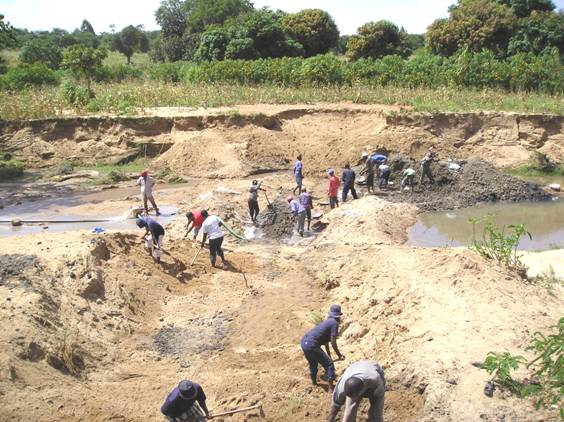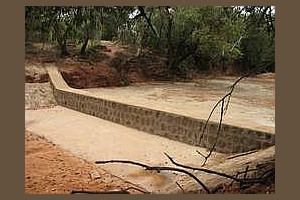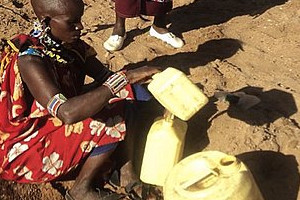地下集水系统

在天然形成冲积层的地方使用地下水坝可在水坝的上游进行蓄水,从而抬高地下水位并防止水分蒸发流失。这样的构造能减少或阻止浅层地下水的流动。通过挖沟至基岩或河底不渗透的土层,地下水坝建在山谷中季节性干旱且含沙的河床上。位于沟渠中的水坝可以由墙或隔板组成,并由挖掘物覆盖直到完全掩盖。填充材料必须适当压实。有两种类型的地下水坝:一种在此介绍,另一种是沙坝。地下水坝更容易修建。因为是在现有的河床中修建,因此发生洪水之后,由于水位变高水量将增加。
适宜条件
- 与沙坝选址要求相似。
- 地下水坝应该修建在泥沙含量足以蓄水的地方。
- 半干旱地区的季节性河流,含有可渗透沉淀物以及浅防渗层(最深3-4米)。
- 通常斜度在1%到2%之间的河谷蓄水量最大。
- 地下水从面积大的流域流向狭窄河道时最为理想。
| 优势 | 劣势 |
|---|---|
| - 地下水坝不容易损坏,也不容易出现裂口 - 水蒸发流失量远远少于干旱热带地区自由水面每年流失两米的水量 |
- 很难发现渗漏情况 - 水可能通过防渗层的缝隙流失了(可以在断裂区挖井并利用水坝作为人工补给建筑物) |
应对环境变化的适应性
干旱
干旱的后果: 可能会干涸
潜在的原因: 降雨减少导致含水层补给变少;人口及用水需求增加;含水层的面积—例如有限的泥沙含量;太多泥沙淤积在水坝后面;水井深度不够;水坝选址不当导致漏水。
增加WASH系统的适应性: 选址正确,施工适当;分阶段修建沙坝以减少泥沙;在上游流域运用保护土壤和水的技术;将抽水井/管道挖得更深一些。
更多关于治理干旱的信息,请查看: 易干旱地区具有适应性的WASH系统.
Construction, operations and maintenance
General advice on cement: A common cause of cracks in structures and linings (e.g. in tanks, dams, waterways, wells) is errors in mixing and applying the cement. First of all, it is important that only pure ingredients are used: clean water, clean sand, clean rocks. The materials have to be mixed very thoroughly. Secondly, the amount of water during mixing needs to minimal: the concrete or cement needs to be just workable, on the dry side even, and not fluid. Thirdly, it is essential that during curing the cement or concrete is kept moist at all times, for at least a week. Structures should be covered with plastic, large leaves or other materials during the curing period, and kept wet regularly.
Specific advice:
The dam can be constructed of concrete, masonry, blockwork, stone-filled gabions with waterproof membranes such as plastic sheet or clay layer, or stabilised soil.
- Build the crest of the underground dam at least 1 metre beneath the ground surface, so the land does not become water-logged.
- Subsurface dams should have wing walls, just like a sand dam does, where you can pile up rocks so that erosion does not occur.
- Water can be abstracted by a well a short distance upstream of the dam, or by a drain system which collects water from the upstream base of the dam and leads it to the downstream side to a well or gravity-pipe system.
- Where possible, a flushing valve is installed to facilitate cleaning of the subsurface reservoir.
- To prevent seepage through the dam, plastic canvas can be used. Plastering mud and water on the downstream side of a trench is recommended to smooth the slope cut and to prevent sharp stones and roots from puncturing the fabric.
Maintenance
- The well or gravity pipe should be regularly cleaned.
- After each large flood, any damage to the dam should be repaired and the dam protected with large stones if necessary.
- For big repairs, such as when a dam has been undermined by infiltration, or damaged by a flood, many people and heavy machinery may be needed, and specialist technicians should be consulted.
- If the groundwater shows increased salinity during the dry season, a discharge pipe could be placed at the bottom of the dam, to allow annual drainage of dissolved salts.
Maintenance can normally be carried out by the users of the system or by a caretaker or watchman. Larger repairs may require skilled labour, which can usually be provided by local craftsmen. In some cases, unskilled labour may be required on a large scale (e.g. for repairing a leaking subsurface dam). The labour may be provided by the users (with or without pay), or by other people who are hired for the purpose.
Users may need to establish a local committee to manage issues, such as controlling or supervising water use, preventing water contamination, carrying out O&M activities, financing O&M, and monitoring how much stored water is still available (a piezometer or auger hole may be installed to allow a caretaker or watchman to estimate how much water is left and decide if rationing has to be introduced). Proper management may also help to prevent social conflict. For O&M tasks at the dam site, a person who lives or farms near this site could be appointed. This person could also be responsible for water alloca- tion and be involved in monitoring activities, if users obtain the water near to, or at, the site. His or her authority should be clear and accepted by all users.
Costs
Initial costs: A 3500 m3 dam costs US$2.40/m3 in Kenya and US$3.90/m3 in Tanzania.
General costs:
- Materials costs and construction: US$1,400
- Feasibility study: US$200
- Technical support: US$275
- Operation and maintenance: low
Field experiences
- A subsurface reservoir in Pernambuco, Brazil has an average depth of 4m, is 50m wide, and 500m long, storing about 4,000m3 of water.
 Dawa Eresa Subsurface and Sand Dam project |
 Feasibility Study for Rainwater Harvesting |
Manuals, videos, and links
- Technology Notes: Subsurface Dams - Section 11. Water Aid.
- Subsurface dams for water storage in dry riverbeds. Waterforaridland.com.
Acknowledgements
- Brikke, François, and Bredero, Maarten. Linking technology choice with operation and maintenance in the context of community water supply and sanitation: A reference document for planners and project staff. World Health Organization and IRC Water and Sanitation Centre. Geneva, Switzerland 2003.
- Smart Water Harvesting Solutions: Examples of innovative, low cost technologies for rain, fog, and runoff water and groundwater. (or alternative link) Netherlands Water Partnership, Aqua for All, Agromisa, et al. 2007.
- CARE Nederland, Desk Study: Resilient WASH systems in drought-prone areas. October 2010.


